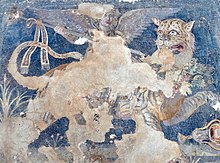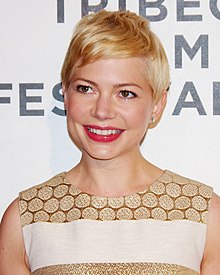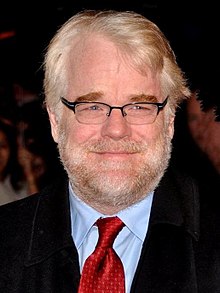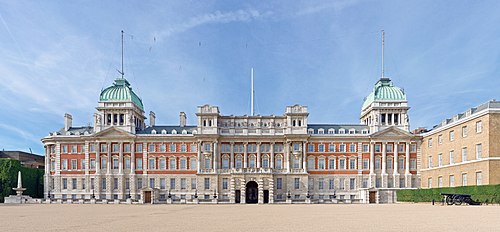Portal:The arts
T H E A R T S P O R T A L
The arts or creative arts are a wide range of human practices of creative expression, storytelling, and cultural participation. They encompass multiple diverse and plural modes of thinking, doing, and being, in an extremely broad range of media. Both dynamic and a characteristically constant feature of human life, they have developed into innovative, stylized, and sometimes intricate forms. This is often achieved through sustained and deliberate study, training, and/or theorizing within a particular tradition, across generations, and even between civilizations. The arts are a vehicle through which human beings cultivate distinct social, cultural, and individual identities while transmitting values, impressions, judgements, ideas, visions, spiritual meanings, patterns of life, and experiences across time and space.
Prominent examples of the arts include:
- visual arts (including architecture, ceramics, drawing, filmmaking, painting, photography, and sculpting)
- literary arts (including fiction, drama, poetry, and prose)
- performing arts (including dance, music, and theatre)
They can employ skill and imagination to produce objects and performances, convey insights and experiences, and construct new environments and spaces.
The arts can refer to common, popular, or everyday practices as well as more sophisticated, systematic, or institutionalized ones. They can be discrete and self-contained or combine and interweave with other art forms, such as the combination of artwork with the written word in comics. They can also develop or contribute to some particular aspect of a more complex art form, as in cinematography. By definition, the arts themselves are open to being continually redefined. The practice of modern art, for example, is a testament to the shifting boundaries, improvisation and experimentation, reflexive nature, and self-criticism or questioning that art and its conditions of production, reception, and possibility can undergo.
As both a means of developing capacities of attention and sensitivity and as ends in themselves, the arts can simultaneously be a form of response to the world and a way that our responses and what we deem worthwhile goals or pursuits are transformed. From prehistoric cave paintings to ancient and contemporary forms of ritual to modern-day films, art has served to register, embody, and preserve our ever-shifting relationships to each other and to the world. (Full article...)
Featured articles -
-
Michelle Ingrid Williams (born September 9, 1980) is an American actress. Known primarily for starring in small-scale independent films with dark or tragic themes, she has received various accolades, including two Golden Globe Awards and a Primetime Emmy Award, in addition to nominations for five Academy Awards and a Tony Award.
Williams, daughter of politician and trader Larry R. Williams, began her career with television guest appearances and made her film debut in the family film Lassie in 1994. She gained emancipation from her parents at age fifteen, and soon achieved recognition for her leading role as Jen Lindley in the teen drama television series Dawson's Creek (1998–2003). This was followed by low-profile films, before having her breakthrough with the drama film Brokeback Mountain (2005), which earned Williams her first Academy Award nomination. (Full article...) -
Dark Angel is an American science fiction drama television series that premiered on the Fox network on October 3, 2000. Created by James Cameron and Charles H. Eglee, it stars Jessica Alba in her breakthrough role. Set in 2019, the series chronicles the life of Max Guevara (Alba), a runaway genetically enhanced supersoldier who escapes from a covert military facility as a child. In a dystopian near-future Seattle, she tries to lead a normal life while eluding capture by government agents and searching for her brothers and sisters scattered in the aftermath of their escape. Dark Angel was the only show produced by the company Cameron/Eglee Productions, and was filmed in Vancouver at Lions Gate Studios.
The high-budget pilot episode marked Cameron's television debut and was heavily promoted by Fox, reaching 17.4 million viewers. The first season, which was shown on Tuesday nights in the United States, received mainly positive reviews and won several awards, including the People's Choice Award for Favorite New TV Drama, and averaged 10.4 million viewers per episode. Alba's portrayal of Max also received mostly positive reviews and several awards. For the second season, the show was moved to the less desirable air time of Friday night and received some criticism for new plot elements. It suffered from a drop in ratings, averaging 6 million viewers per episode, and was canceled. (Full article...) -
The Dance of the Twisted Bull (Spring/Summer 2002; Spanish: El baile del toro retorcido) is the nineteenth collection by British designer Alexander McQueen for his eponymous fashion house. Twisted Bull was inspired by Spanish culture and art, especially the traditional clothing worn for flamenco dancing and bullfighting. In McQueen's typical fashion, the collection included sharp tailoring and historicist elements and emphasised femininity and sexuality.
The runway show for Twisted Bull was staged during Paris Fashion Week on 6 October 2001 at the headquarters of the Stade Français sports club. It was McQueen's first collection following his departure from Givenchy and the sale of his company to the Gucci Group in 2001. Compared to his previous seasons, which tended to be theatrical and artistic, the runway show was simple, and the clothing designs were unusually commercial. McQueen confirmed that this was a business decision intended to drive sales for his first season under Gucci. Sales for the collection were reportedly strong. (Full article...) -
The Green Child is the only completed novel by the English anarchist poet and critic Herbert Read. Written in 1934 and first published by Heinemann in 1935, the story is based on the 12th-century legend of two green children who mysteriously appeared in the English village of Woolpit, speaking an apparently unknown language. Read described the legend in his English Prose Style, published in 1931, as "the norm to which all types of fantasy should conform".
Each of the novel's three parts ends with the apparent death of the story's protagonist, President Olivero, dictator of the fictional South American Republic of Roncador. In each case Olivero's death is an allegory for his translation to a "more profound level of existence", reflecting the book's overall theme of a search for the meaning of life. Read's interest in psychoanalytic theory is evident throughout the novel, which is constructed as a "philosophic myth ... in the tradition of Plato". (Full article...) -
No Depression is the first studio album by alternative country band Uncle Tupelo, released in June 1990. After its formation in the late 1980s, Uncle Tupelo recorded the Not Forever, Just for Now demo tape, which received a positive review by the College Media Journal in 1989. The review led to the band's signing with what would become Rockville Records later that year. The album was recorded with producers Sean Slade and Paul Q. Kolderie at Fort Apache Studios, on a budget of US$3,500.
No Depression was critically acclaimed and sold well for an independent release. Selling over 15,000 copies within a year of its release, the album's success inspired the roots music magazine No Depression. The record is considered one of the most important alternative country albums, and its title is often used as a synonym for the alternative country genre after being popularized by No Depression magazine. After regaining the rights to the album through a lawsuit, Uncle Tupelo released a remastered version in 2003 through Legacy Records, expanded to include six bonus tracks. (Full article...) -

Gustav Holst, c. 1921 photograph by Herbert Lambert
Gustav Theodore Holst (born Gustavus Theodore von Holst; 21 September 1874 – 25 May 1934) was an English composer, arranger and teacher. Best known for his orchestral suite The Planets, he composed many other works across a range of genres, although none achieved comparable success. His distinctive compositional style was the product of many influences, Richard Wagner and Richard Strauss being most crucial early in his development. The subsequent inspiration of the English folksong revival of the early 20th century, and the example of such rising modern composers as Maurice Ravel, led Holst to develop and refine an individual style.
There were professional musicians in the previous three generations of Holst's family and it was clear from his early years that he would follow the same calling. He hoped to become a pianist, but was prevented by neuritis in his right arm. Despite his father's reservations, he pursued a career as a composer, studying at the Royal College of Music under Charles Villiers Stanford. Unable to support himself by his compositions, he played the trombone professionally and later became a teacher—a great one, according to his colleague Ralph Vaughan Williams. Among other teaching activities he built up a strong tradition of performance at Morley College, where he served as musical director from 1907 until 1924, and pioneered music education for women at St Paul's Girls' School, where he taught from 1905 until his death in 1934. He was the founder of a series of Whitsun music festivals, which ran from 1916 for the remainder of his life. (Full article...) -
Philip Seymour Hoffman (July 23, 1967 – February 2, 2014) was an American actor. Known for his distinctive supporting and character roles—eccentrics, underdogs, and misfits—he acted in many films and theatrical productions, including leading roles, from the early 1990s until his death in 2014. He was voted one of the 50 greatest actors of all time in a 2022 readers' poll by Empire magazine.
Hoffman studied acting at New York University's Tisch School of the Arts. He gained recognition for his supporting work, notably in Scent of a Woman (1992), Boogie Nights (1997), Happiness (1998), The Big Lebowski (1998), Magnolia (1999), The Talented Mr. Ripley (1999), and Almost Famous (2000). He began to occasionally play leading roles, and for his portrayal of the author Truman Capote in Capote (2005), won the Academy Award for Best Actor. Further Oscar nominations came for playing a brutally frank CIA officer in Charlie Wilson's War (2007), a priest accused of child sexual abuse in Doubt (2008), and the charismatic leader of a Scientology-type movement in The Master (2012). (Full article...) -
Paradises Lost is a science fiction novella by American author Ursula K. Le Guin. It was first published in 2002 as a part of the collection The Birthday of the World. It is set during a multigenerational voyage from Earth to a potentially habitable planet. The protagonists, Liu Hsing and Nova Luis, are members of the fifth generation born on the ship. The story follows them as they deal with members of religious cult who do not believe in the ship stopping at its intended destination. They also face a crisis brought on by a drastic change in the ship's schedule. The novella has since been anthologized as well as adapted into an opera of the same name.
The novella explores the isolation brought on by space travel, as well as themes of religion and utopia. It contains elements of ecocriticism, or a critique of the idea that human beings are altogether separate from their natural environment. The novella and the collections it was published in received high praise from commentators. For its generation ship setting and examination of utopia, critics compared it to other Le Guin works such as "Newton's Sleep", and The Telling, as well as to the works of Gene Wolfe and Molly Gloss. Scholar Max Haiven described the novella as "a chastening lesson in both the potential and the perils of freedom", while author Margaret Atwood said that it "shows us our own natural world as a freshly discovered Paradise Regained, a realm of wonder". (Full article...) -
Michael Tritter is a recurring fictional character in the medical drama series House, portrayed by David Morse. He is the main antagonist of the third season, which ran between 2006 and 2007. Tritter is a police detective, who tries to get Dr. Gregory House (Hugh Laurie) to apologize for leaving him in an examination room with a thermometer in his rectum. After House refuses to apologize, Tritter researches House's background and discovers his Vicodin addiction. Tritter turns people close to House against him and forces House to go to rehab. When the case ultimately comes to court, the judge sentences House to one night in jail, for contempt of court, and to finish his rehabilitation, telling Tritter that she believes House is not the drug addict he tried to make him out to be.
The character was created as somebody who could go "toe-to-toe" with House. Morse, who had never seen the show before, was unsure if he could portray the character, and was not impressed after familiarizing himself with the show. The excited reaction of his friends to the opportunity convinced him to take the role. Initial critical responses to the character were mostly positive, but critics later felt that the six-episode Tritter story arc became "boring". Morse, though, was praised for his portrayal and received a nomination for the Primetime Emmy Award for Outstanding Guest Actor in a Drama Series for his appearance in the episode "Finding Judas". Morse stated in a 2006 TV Guide interview that, although he had discussed it with writers of the show, bringing the character back on the show would be "practically impossible". (Full article...) -
Soultaker is a 1990 American fantasy horror film written by Vivian Schilling and directed by Michael Rissi. It stars Joe Estevez in the title role, alongside Vivian Schilling, Gregg Thomsen, Chuck Williams, Robert Z'Dar, and David "Shark" Fralick. The film follows a group of young adults who try to flee from the titular "Soultaker" when their souls are ejected from their bodies after a car accident. Inspired by discussions with Action International Pictures producer Eric Parkinson, the script was based on a real-life car accident which Schilling was involved in.
The film was shot in five weeks on a $250,000 budget. Originally planned for a direct-to-video release, it saw limited theatrical screenings, with eight prints distributed in United States. Since its release, the film has received negative reviews, but won the Saturn Award for "Best Genre Video Release" in 1992. A sequel was planned, and actors such as James Earl Jones and Faye Dunaway were named for the cast, but the film was never made and Schilling turned its premise into a novel which was titled Quietus, published in 2002. Soultaker was featured in the tenth-season premiere episode of the comedy television series Mystery Science Theater 3000 in 1999. (Full article...) -

The mosaics of Delos are a significant body of ancient Greek mosaic art. Most of the surviving mosaics from Delos, Greece, an island in the Cyclades, date to the last half of the 2nd century BC and early 1st century BC, during the Hellenistic period and beginning of the Roman period of Greece. Hellenistic mosaics were no longer produced after roughly 69 BC, due to warfare with the Kingdom of Pontus and the subsequently abrupt decline of the island's population and position as a major trading center. Among Hellenistic Greek archaeological sites, Delos contains one of the highest concentrations of surviving mosaic artworks. Approximately half of all surviving tessellated Greek mosaics from the Hellenistic period come from Delos.
The paved walkways of Delos range from simple pebble or chip-pavement constructions to elaborate mosaic floors composed of tesserae. Most motifs contain simple geometric patterns, while only a handful utilize the opus tessellatum and opus vermiculatum techniques to create lucid, naturalistic, and richly colored scenes and figures. Mosaics have been found in places of worship, public buildings, and private homes, the latter usually containing either an irregular-shaped floor plan or peristyle central courtyard. (Full article...) -

Terry-Thomas in Where Were You When the Lights Went Out? (1968)
Terry-Thomas (born Thomas Terry Hoar Stevens; 10 July 1911 – 8 January 1990) was an English character actor and comedian who became internationally known through his films during the 1950s and 1960s. He often portrayed disreputable members of the upper classes, especially cads, toffs and bounders, using his distinctive voice; his costume and props tended to include a monocle, waistcoat and cigarette holder. His striking dress sense was set off by a 1⁄3-inch (8.5 mm) gap between his two upper front teeth.
Born in London, Terry-Thomas made his film debut, uncredited, in The Private Life of Henry VIII (1933). He spent several years appearing in smaller roles, before wartime service with Entertainments National Service Association (ENSA) and Stars in Battledress. The experience helped sharpen his cabaret and revue act, increased his public profile and proved instrumental in the development of his successful comic stage routine. On his demobilisation, he starred in Piccadilly Hayride on the London stage and was the star of the first comedy series on British television, How Do You View? (1949). He appeared on various BBC Radio shows, and made a successful transition into British films. His most creative period was the 1950s when he appeared in Private's Progress (1956), The Green Man (1956), Blue Murder at St Trinian's (1957), I'm All Right Jack (1959) and Carlton-Browne of the F.O. (1959). (Full article...) -
System Shock is a 1994 first-person action-adventure video game developed by LookingGlass Technologies and published by Origin Systems. It was directed by Doug Church with Warren Spector serving as producer. The game is set aboard a space station in a cyberpunk vision of the year 2072. Assuming the role of a nameless security hacker, the player attempts to hinder the plans of a malevolent artificial intelligence called SHODAN.
System Shock's 3D engine, physics simulation and complex gameplay have been cited as both innovative and influential. The developers sought to build on the emergent gameplay and immersive environments of their previous games, Ultima Underworld: The Stygian Abyss and Ultima Underworld II: Labyrinth of Worlds, by streamlining their mechanics into a more "integrated whole"; it is considered one of the defining examples of an immersive sim. (Full article...) -

Micronations and the Search for Sovereignty is a 2021 book by Australian constitutional law specialists Harry Hobbs and George Williams about micronations and their legal status. Written from an academic perspective, it is one of few works on micronational movements and the earliest-published book to focus largely on the legal aspect of micronations. The book concerns the definition of statehood, the place of micronations within international law, people's motivations for declaring them, the micronational community and the ways by which such entities mimic sovereign states. In 2022 Hobbs and Williams published a book for a broader audience, How to Rule Your Own Country: The Weird and Wonderful World of Micronations. (Full article...) -

Funerary Monument to Sir John Hawkwood: the figure is larger than life-size, central panel (1436), measures 732 × 404 cm (288 × 159 in); with Trompe-l'œil grotto-esque frame added in 1524, 820 × 515 cm (323 × 203 in).
The Funerary Monument (or Equestrian Monument) to Sir John Hawkwood is a fresco by Paolo Uccello, commemorating English condottiero John Hawkwood, commissioned in 1436 for Florence Cathedral. The fresco is an important example of art commemorating a soldier-for-hire who fought in the Italian peninsula and is a seminal work in the development of perspective.
The politics of the commissioning and recommissioning of the fresco have been analyzed and debated by historians. The fresco is often cited as a form of "Florentine propaganda" for its appropriation of a foreign soldier of fortune as a Florentine hero and for its implied promise to other condottieri of the potential rewards of serving Florence. The fresco has also been interpreted as a product of internal political competition between the Albizzi and Medici factions in Renaissance Florence, due to the latter's modification of the work's symbolism and iconography during its recommissioning. (Full article...)
Featured picture
Did you know...
- ... that Albrecht Dürer's pupil Hans Springinklee is best known for his woodcuts (example pictured)?
- ... that the lyrics of Naer Mataron, a black metal band from Greece, are influenced by Greek mythology?
- ... that the Villa Medici del Trebbio was one of the first of the Medici villas outside Florence?
In this month
- 5 May 1726 – Handel's opera Alessandro premieres at the King's Theatre in London with Italian castrato singer Senesino in the title role
- 12 May 1926 – Dmitri Shostakovich's Symphony No. 1, which he composed at the age of 19 while a student at Leningrad Conservatory, receives its first performance
- 22 May 1844 – Impressionst painter and printmaker Mary Cassatt (self-portrait pictured) is born in Allegheny, Pennsylvania
- 26 May 1897 – Bram Stoker's novel Dracula, which later became the subject of numerous theatrical, film and television interpretations, is published by Constable & Co.
- 29 May 1913 – Igor Stravinsky's ballet The Rite of Spring premieres in Paris and causes a riot in the audience between supporters and opponents of the work
News
- August 5: DaBaby Levitating remix losing US radio audiences after the rapper's comments on HIV/AIDS
- June 11: Taylor Swift's Evermore records biggest sales week of the year as it returns to No 1 on album chart
- May 27: Olivia Rodrigo's song good 4 u debuts at No 1 on US Billboard Hot 100 chart
- May 25: 'Rock and roll never dies': Italy wins Eurovision after 30 years
- February 10: Disney to shut down Blue Sky Studios, animation studio behind 'Ice Age'
Featured biography
El Lissitzky was a Russian artist, designer, photographer, teacher, typographer, and architect. He was one of the most important figures of the Russian avant-garde, helping develop suprematism with his friend and mentor, Kazimir Malevich, and designed numerous exhibition displays and propaganda works for the former Soviet Union. His work greatly influenced the Bauhaus, Constructivist, and De Stijl movements and experimented with production techniques and stylistic devices that would go on to dominate 20th century graphic design. Lissitzky's entire career was laced with the belief that the artist could be an agent for change, later summarised with his edict, "das zielbewußte Schaffen" (The task-oriented creation). In 1941 he produced one of his last known works — a Soviet propaganda poster rallying the people to construct more tanks for the fight against Nazi Germany. (Full article...)
Featured audio
Selected quote
| “ | It is not beauty that endears; it’s love that makes us see beauty. | ” |
Categories
WikiProjects
Parent project
Descendant projects
Related portals
Things you can do
- Check the recent changes page for improvements, other changes, and vandalism to these articles
- Article requests: Requests articles (arts and entertainment)
- Deletion discussions: Listed at Wikipedia:WikiProject Deletion sorting/Arts
- Expand: check Visual arts stubs to expand
- Notability: Articles with notability concerns, listed at WikiProject Notability
- Requested pictures: Arts topics, requested pictures




























